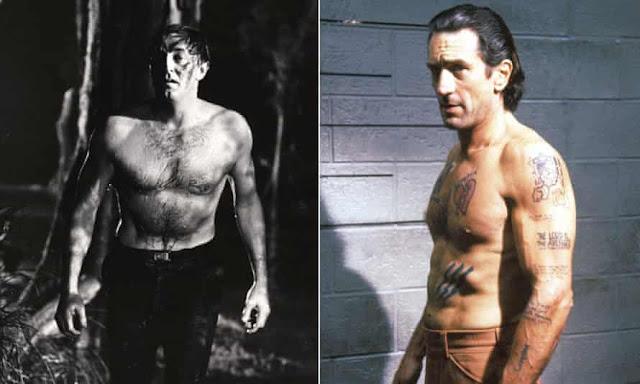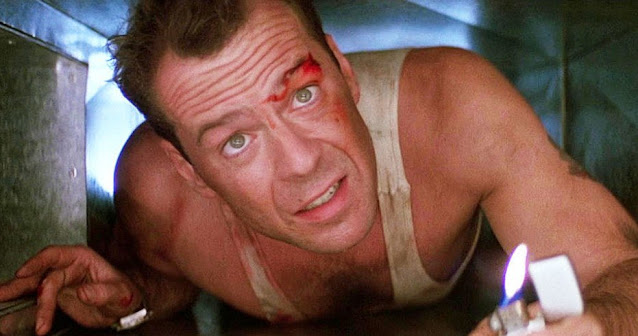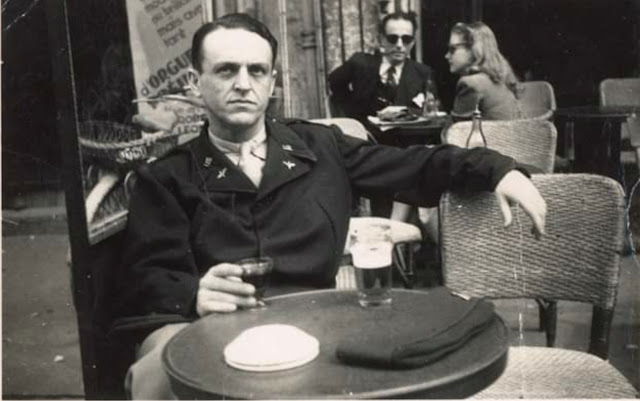"Cape Fear": Re-Making 'Max Cady,' De Niro-Style
Long before any of the other participants were sure it was a good idea, Robert De Niro took a strong interest in remaking the classic 1962 thriller Cape Fear. "I liked the original Cape Fear,” De Niro said. “It was fun to watch, and it made an impression on me as a kid. It was a little naive in some ways and simplistic, but there was something about it. I had this image of Robert Mitchum like a Charles Manson, someone who does a mind trip and is not just a physical threat. That's why I was happy I was doing Cape Fear with Marty. I felt he'd have an understanding of the complexity."
 |
| Robert Mitchum as 'Max Cady' in 1962 vs. Robert De Niro as 'Max Cady' in 1991 |
Martin Scorsese took the role of director at De Niro’s urging. “I hadn’t worked with Bobby on a role that big for a long time, so that was exciting,” said Scorsese. “He really wanted to play this character, and when he’s as fully dedicated to a part as he was to this one, you just know that something great might happen.”
"Bob had this concept that Cady starts out human and becomes more than human at the end of the film,” Scorsese explained. “We're trying to make a transition from a psychologically realistic film to a movie landscape where the main characters battle out a movieland apocalyptic vision, like Judgment Day. My reason for this, and I hope you don't have to know it to enjoy the picture, is that Max takes on all the guilts, all the things we feel bad about, all the transgressions we've made, the things that will always be with us. That was my approach. Bob had other approaches."
De Niro did a great deal of research into how men like ‘Max Cady’ behave in the modern day. “I talked to some people and I had a field researcher, Alan Greenberg, go around with a tape recorder and tape people who had been in jail for rape and the things that Max Cady had done, all through the South. And I looked at all of the tapes and picked up different things from them. I was just looking, sort of trolling for anything that I could use. I talked to all kinds of people, some who really might not even been exactly like him, including some people in Bellevue and some doctors. It was quite interesting.”
De Niro took what he had found to Scorsese, who was still working on the script with screenwriter Wesley Strick. Scorsese recalled, “We worked on the script with Wesley just ahead of shooting, trying to get a little more of that research in here and there.”
Wesley Strick was hard at work trying to tailor his script to the sensibilities of the director and stars. “I tried to create a psychopath who is more interesting, who has a real sense of himself being on a religious quest,” Strick explained. “The vengeance that he’s seeking is pure and just and cleansing – not only for him, but for Sam, too. I mean, he absolutely believes that he’s Sam’s doom, but he’s also Sam’s redemption. And I think Marty really sees Cady’s point of view. He can let his vision extend to the most black part of his characters.”
Strick introduced one element to De Niro’s character that was entirely absent from the 1962 original. “I wanted to make ‘Max Cady’ kind of a monster of the South, a creature who had crawled out of the muck of the South – the aspects of the South that were the most primitive and the most terrifying,” said Strick. “So I fastened on the idea of him having emerged from this Pentecostal background. He says in the movie, ‘Grandpa was a snake handler and Grandma drank arsenic,’ or something like that, which I’d read about – apparently there were these Pentecostal sects, and there may still be, in the backwoods and the hills, who practice this sort of Christianity. And I thought, ‘What a wonderful background for a guy who sees himself as an avenging angel, as somebody not necessarily bound by the natural laws of pain, and he sees himself as… sort of a backwoods Pentecostal Superman.”
Scorsese welcomed De Niro and Strick’s ideas, and even found ways to put some of them on screen, particularly in the opening scene in ‘Cady’s’ prison cell. “The image of Stalin seen near the beginning of the film evokes the Man of Steel, which is what Max wants to be. His philosophy is Nietzsche’s ‘superman’ in its most negative form. He also identifies with Alexander the Great and with San Felipe de Jesus, who was impaled on spears, because he sees himself as a victim. There are these conflicting ideas chasing around ‘Cady’s’ psyche which make him believe that he’s an instrument of God, carrying out his revenge.”
Hal Hinson, “Scorsese, Master of the Rage,” Washington Post, 11/24/91
Peter Keough, “Cape Crusader,” Chicago Sun-Times, 11/17/91
Ian Christie & David Thompson, Scorsese on Scorsese, Faber & Faber, 2003
Cape Fear (1991) DVD: “The Making of Cape Fear” Featurette
David Morgan, “Scorsese Tackles the Thriller with Fear Remake,” Chicago Sun-Times, 2/24/91



Comments